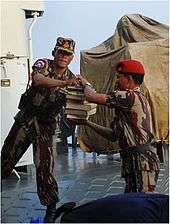Fairbairn–Sykes fighting knife
| Fairbairn–Sykes fighting knife | |
|---|---|
|
F-S fighting knife – ring grip pattern | |
| Type | Dagger |
| Place of origin | United Kingdom |
| Service history | |
| In service | 1941–present |
| Used by | See Users |
| Wars | World War II-present |
| Production history | |
| Designer | William Ewart Fairbairn and Eric Anthony Sykes |
| Designed | 1941 |
| Manufacturer | Wilkinson Sword Ltd |
| Produced | 1941 |
| Specifications | |
| Length | 11.5 inches (29 cm) |
| Blade length | 7 inches (18 cm) |
|
| |
| Blade type | Dagger |
| Hilt type | Metal |
| Scabbard/sheath | Metal |
| Head type | Metal |
| Haft type | Metal |

The Fairbairn–Sykes fighting knife is a double-edged fighting knife resembling a dagger or poignard with a foil grip developed by William Ewart Fairbairn and Eric Anthony Sykes in Shanghai based on concepts which the two men initiated before World War II while serving on the Shanghai Municipal Police in China.[1]
The F-S fighting knife was made famous during World War II when issued to British Commandos, the Airborne Forces, the SAS and many other units, especially for the Normandy landings in June 1944. With its acutely tapered, sharply pointed blade, the F-S fighting knife is frequently described as a stiletto, a weapon optimised for thrusting,[2] although the F-S knife is capable of being used to inflict slash cuts upon an opponent when its cutting edges are sharpened according to specification.[3] The Wilkinson Sword Company made the knife with minor pommel and grip design variations.
The F-S knife is strongly associated with the British commandos and the US Office of Strategic Services (OSS) and Marine Raiders (who based their issued knife on the Fairbairn-Sykes), among other special forces / clandestine / raiding units. It features in the insignia of the British Royal Marines, the Belgian Commandos, the Dutch Commando Corps, founded in the UK during World War II, the Australian 1st Commando Regiment and 2nd Commando Regiment, and the United States Army Rangers, both founded with the help of the British Commandos. Large numbers of Fairbairn Sykes knives of varying types, including some with wooden grips, were used by the 3rd Canadian Infantry Division that landed on Juno Beach on "D" Day and by the men of the 1st Canadian Parachute Battalion who jumped and fought on the same day. A solid gold F-S fighting knife is part of the commandos' memorial at Westminster Abbey.
The first batch of fifty F-S fighting knives were produced in January 1941 by Wilkinson Sword Ltd after Fairbairn and Sykes had travelled to their factory from the Special Training Centre at Lochailort in November 1940 to discuss their ideas for a fighting knife.[4]
The F-S fighting knife remains in production because of continued use in hand-to-hand combat situations around the world.
Design

The F-S fighting knife was designed exclusively for surprise attack and fighting, with a slender blade that can easily penetrate a ribcage. The vase handle grants precise grip, and the blade's design is especially suited to its use as a fighting knife. Fairbairn's rationale is in his book Get Tough! (1942).
In close-quarters fighting there is no more deadly weapon than the knife. In choosing a knife there are two important factors to bear in mind: balance and keenness. The hilt should fit easily in your hand, and the blade should not be so heavy that it tends to drag the hilt from your fingers in a loose grip. It is essential that the blade have a sharp stabbing point and good cutting edges, because an artery torn through (as against a clean cut) tends to contract and stop the bleeding. If a main artery is cleanly severed, the wounded man will quickly lose consciousness and die.[5]
The Fairbairn-Sykes was produced in several patterns. The Shanghai knife on which it was based was only about 5.5 in (14 cm) long in the blade. First pattern knives have a 6.5 in (17 cm) blade with a flat area, or ricasso, at the top of the blade which was not present on the original design and the presence of which has not been explained by the manufacturers, under the S-shaped crossguard. Second-pattern knives have a slightly longer blade (just less than 7 in (18 cm)), 2 in (5.1 cm)-wide oval crossguard, knurled pattern grip, and rounded ball, and may be stamped "ENGLAND" (a US legal requirement when importing the surplus knives after WWII, as they had to show the country of origin) on the handle side of the cross guard. Some may also be stamped with a "Broad Arrow" /|\ British issue mark and a number (e.g., 21) on the opposite handle side of the cross guard. Third-pattern knives also have a similarly sized seven-inch blade, but the handle was redesigned to be a ringed grip. This ringed grip is reputed to have distressed one of the original designers as it unbalanced the weapon and made harder to hold when wet, but it was used by the manufacturers as it was simple to produce and could be cast from a cheaper and more plentiful alloy instead of using up scarce quantities of brass stock which were, of course, required for ammunition casings and other such vital applications. William Rodgers, as part of the Egginton Group, now also produce an all-black "sterile" version of the knife, which is devoid of any markings showing maker for NATO use.
The length of the blade was chosen to give several inches of blade to penetrate the body after passing through the 3 in (7.6 cm) of the thickest clothing that was anticipated to be worn in the war, namely that of Soviet greatcoats. Later production runs of the F-S fighting knife have a blade length that is about 7.5 in (19 cm).
In all cases the handle had a distinctive foil-like grip to enable a number of handling options. Many variations on the F-S fighting knife exist in regards to size of blade and particularly of handle. The design has influenced the design of knives throughout the many decades since its introduction.
Copies
Because of the success of the Fairbairn-Sykes Knife in World War II and in the wars in Korea and Vietnam, many companies made their own versions of the F-S fighting knife, such as the 1966 Gerber Mark II.
Almost two million of the British knives were made. Early production runs were extremely limited and demand was high, with many British troops attempting to buy their own.
OSS version

The OSS Stiletto was a double-edged knife based on the Fairbairn–Sykes fighting knife. It was so admired that the US military created several other fighting knives based on it. The US Office of Strategic Services's knife manufacturing bid was approximately one-fifteenth of the British equivalent, but the US version of the knife, manufactured by Landers, Frary & Clark, of New Britain, Connecticut was improperly tempered and inferior to the British F-S Fighting Knife in materials and workmanship. Its reputation suffered accordingly.[3] A total of 20,000 units of the OSS version were produced. The OSS dagger was officially replaced in service in 1944 by the US M3 Fighting Knife.[6] The scabbard for the OSS Stiletto looks like a pancake spatula but this is because of the design so that can be worn high or low on the belt, or angled either left or right. In theory this gave a very adaptable mounting system, but the sheet metal was like a knife itself, especially to a parachutist.
Other knives by Fairbairn
General Robert T. Frederick of the Devil's Brigade (First Special Service Force) is credited with a similar weapon, the "V-42 Commando Knife" V-42 Stiletto, itself a derivation of the F-S design. The V-42 was manufactured by W. R. Case & Sons Cutlery Co. in the US circa 1942-43 and is distinguished mainly by its markings and the presence of a small, scored indentation for the wielder's thumb, to aid in orienting the knife for thrusting. Fairbairn has been given full or partial credit for the design of several other fighting knives, including the smatchet.
Users

-
 United Kingdom
United Kingdom
- Royal Marines
- Personnel who have completed the All Arms Commando Course
-
 France
France
- Commandos Marine
- Personnel who have completed the Stage Commando in Lorient
-
 Poland
Poland
- 1st Independent Parachute Brigade
- 1 Samodzielna Kompania Commando / 6 Troop No. 10 Commando
-
.svg.png) Belgium
Belgium
-
 Canada
Canada
-
 Cambodia
Cambodia
-
 Indonesia
Indonesia
-
 Malaysia
Malaysia
-
 Singapore
Singapore
See also
- Applegate-Fairbairn fighting knife
- BC-41
- Corvo—Chilean Commando Knife
- Cuchillo De Paracadaista—Argentine Paratrooper Knife
- List of daggers
- Ranger Memorial—American monument featuring the Fairbairn-Sykes
- Stiletto
- Smatchet
- V-42 Stiletto
- "Yank" Levy fighting knife
- M3 fighting knife
- NR-40
References
- ↑ Chambers, John W., OSS Training in the National Parks and Service Abroad in World War II, Washington, DC, US National Park Service (2008), p. 191: Fairbairn joined the Shanghai Municipal Police (SMP) in 1907. During his service with the International Police in Shanghai, Fairbairn reportedly engaged in hundreds of street fights in the course of his duties over a twenty-year career. Much of his body, arms, legs, torso, even the palms of his hands, was covered with scars from knife wounds from those fights.
- ↑ Dunlop, Richard, Behind Japanese Lines: With the OSS in Burma, New York: Time Life Co., ISBN 0-8094-8579-6, ISBN 978-0-8094-8579-6 (1991): "Fairbairn had invented a stiletto as precise as a surgeon's scalpel. He wielded it with a flashing, slashing vigor that invariably proved fatal to an opponent. 'Why is it so long and thin?' I asked him one day in a question period during my own course of instruction. 'It doesn't have a cutting edge.' 'It doesn't leave any marks on the body,' he replied. 'Scarcely more than a tiny drop of blood.'"
- 1 2 Cassidy, William L., A Brief History of the Fairbairn–Sykes Fighting Knife
- ↑ Allan, Stuart. Commando Country. Edinburgh: National Museums Scotland, 2007. ISBN 978-1-905267-14-9.
- ↑ Fairbairn, W.E. (December 1996) [1942]. Get Tough (new ed.). Boulder, Colo.: Paladin Press. ISBN 0-87364-002-0.
- ↑ Chambers, John W., OSS Training in the National Parks and Service Abroad in World War II, Washington, DC, US National Park Service (2008), p. 191
Further reading
- Buerlein, Robert. (2002). Allied Military Fighting Knives: And The Men Who Made Them Famous. Paladin Press. ISBN 1-58160-290-1
- Flook, Ron. (1999). British and Commonwealth Military Knives. Howell Press Inc. ISBN 1-57427-092-3
- Locken, Alan. (1995). The Collectors Guide to the Fairbairn Sykes Fighting Knife. Alan W Locken.
- Peter-Michel, Wolfgang: The Fairbairn-Sykes Fighting Knife: Collecting Britain's Most Iconic Dagger. Schiffer Publishing Ltd. ISBN 0-7643-3763-7
- Wilkinson-Latham, Robert. (2009). Wilkinsons and the F.S. Fighting Knife. 2nd ed. Pooley Sword Publishing. ISBN 978-1-84336-156-5
External links
| Wikimedia Commons has media related to Fairbairn-Sykes Fighting Knife. |
